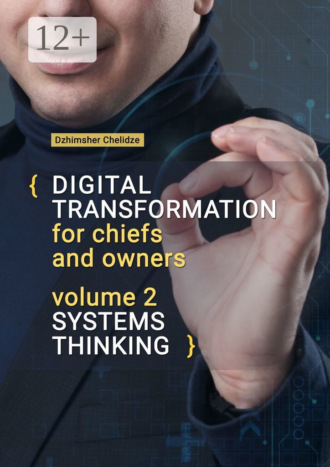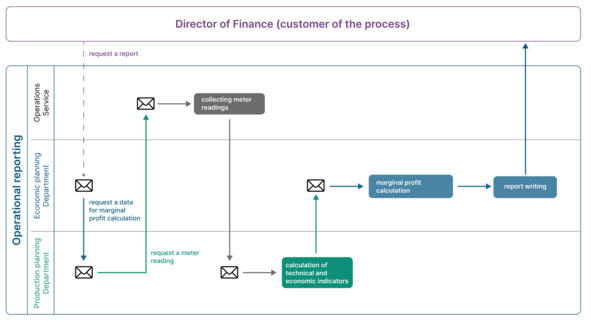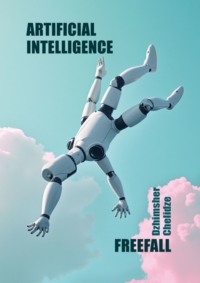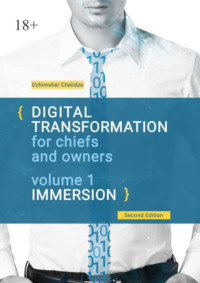
Полная версия
Digital transformation for chiefs and owners. Volume 2. Systems thinking
– Supplier (supplier) – person or company that supply resources for the execution of the business process (production, money, materials, data);
– Input (input) – resources for business process: materials, money, production capacity, data);
– Process (process) – all those tasks that allow the result of the work to convert the raw material into the final product;
– Output (output) – products of business process activity;
– Customer (customer) – recipients of services, those who use the product of the business process.
The SIPOC business process is described from the end:
– Identify the customer of the business process;
– Describe the final product (output) that the customer needs;
– Highlight 5—7 key business process operations;
– Identify the necessary resources (input) for the business process;
– Identify the providers of these resources
The key advantage is the speed of description, the ability to identify unnecessary steps that do not create value. This approach is somewhat similar to VAD and is a top-level description. Allows to identify the most obvious losses.
Process Event Chain (EPC)
This approach describes business processes in the form of individual stages/steps of the process and events that initiate these steps, that is, the structure of the «event – function – event» is obtained. This method is well suited for standardizing business processes and analysing the flow of documents and necessary information throughout the business process.
Main elements of the description:
– An event is something that creates the need for action.
– Function is an action to get the desired result, in response to an event.
– Performers are those who perform the function, including approving, coordinating, etc.
– Resources are all that are necessary for the implementation of the function: money, information systems or individual modules, documents, operational risks.
Unlike the previous approach, where the beginning was on the left and the finish on the right, everything starts from the top and goes down.
Description algorithm:
– Determine what we have and what we want – boundary events.
– Describe intermediate events that are inside this process and what tasks need to be performed / to implement functions.
– We add all the necessary information on implementers and resources.
– Analysis of the completeness and quality of the scheme, whether it takes into account all variations and sub-processes. If necessary, make additional schemes for sub-processes. However, here I recommend always remember the rule from the first book – one scheme, one sheet or screen.
Plus, the approach – the ability to then create clear rules in the form of text or table. This notation is quite common, especially in large organizations, because on the one hand it standardizes the description and on the other it is quite flexible. For example, it is often used to configure ERP systems.
BPMN 2.0 (Business Process Model and Notation 2.0)
BPMN – today a de facto standard in the description of business processes with a wide set of graphical elements for modelling. If for ordinary users and managers this is not the most convenient approach, then for business analysts it is a mandatory tool: to describe within this approach a fairly large process on one sheet will be difficult, in addition, the approach is quite strict, However, this is more detailed and it is easier to identify local errors.
An example of the description in this notation below.

An example of a simplified BPMN scheme
What I observe in life and apply myself
Unfortunately, in 99% of companies or no description of business processes, no top-level or even more detailed, or it is formally and made to tick, and in life everything works differently. Additionally, as long as the organization is small, 5—10 people, it is not scary. But after it begins to grow, chaos becomes more expensive pleasure.
In my life I adjust to the task, the level of maturity of the company and employees. It is mainly a hybrid of EPC and Notation Procedure (more on QR code at the beginning of a section), and sometimes a simple flowchart.
Summary 1 of the chapter and recommendations
More importantly: organizational structure or business processes described? Where to start? This is a perennial discussion. My personal opinion: as long as the company is small, it is becoming or restructuring, the selection of the business model that will give a result, you can do without business processes. If you have an organizational structure, clearly defined functions, a key product and, preferably, metrics (I do not make this a must, because I have seen isolated cases of a qualitatively developed system of key indicators), then you will not drown in chaos. People will be able to communicate and negotiate among themselves, which is a key element. I would even say that it is a useful exercise to first teach people to work together, sharing power, responsibility and resources, and then to implement process management. As a result, the work with the Org. structure will create a skeleton of the management system, including:
– ensure efficient use of resources;
– increase productivity;
– minimize the need for regulations, rules, detailed descriptions of each business process, in general, in the work with paper;
– minimize risks to the company, especially those related to dependence on individuals;
– reduce people’s congestion and turnover. Instead of one or two universal «working horses» there will be a distribution of tasks, the uncertainty that causes stress and burnout will be reduced;
– unload yourself as a leader: you do not have to often interfere with processes and understand conflicts, as the system will become transparent, everyone will understand their area of responsibility. It’ll be easier to pick up people and prepare job descriptions.
In addition, in the early stages, including the start of digitalization, your business processes will change too often, and constantly change and update them – too expensive a pleasure. Additionally, if you describe and «freeze», you lose the main advantage of the young team – its flexibility. The exception is critical processes with high risks and back-office processes, they are often stable and better dealt with initially.
However, after the initial stage is completed, it is necessary to engage in business processes. It is not necessary to fix everything and detail, but the most critical processes, where the risks are high, where problems begin to occur, should be described at least at the upper levels. Top-level approaches have the main advantage – speed and simplicity. And this will have an effect, and therefore, resources and motivation for in-depth work.
For grown-up companies there is another problem – bureaucracy. There is already a reverse approach – simplification of business processes. In general, as always, the search for a balance between chaos and entrepreneurship and order with bureaucracy.
As I said earlier, the right org is important. structure, proper distribution of authority, resources, responsibility and people, taking into account their psychology, system and personality balance. Additionally, if you listen to the classic science of Peter Drucker’s administration, you have to initially describe who you need, and then you have to choose the person for these tasks. This is the key message of his work «Effective Leader». But I have a slightly different opinion here.
This approach in a pure form is viable in an already mature company, where the requirements for candidacy are grounded, and the structure is balanced. In addition, such a company is attractive in the market due to the decent payment and the established reputation. If you are still young, you do not have a balanced system and/or you do not have a queue of applicants, then a certain flexibility is required. Yes, it is better to base on the principle of Peter Drucker, but the organizational structure needs to be adapted to the available resources and people, their psychological qualities, soft skills and competencies. That is, as usual, remember how to, but seek balance with what is.
This is basically the basic rule of life, and there is no ideal solution or methodology for either organizational structures, business processes, or project management approaches and so on. It is impossible to get rid of the psychology of people and technologies or tools to solve all problems, but to strive for an effective and autonomous system is necessary.
If you decide to approach the search for a new employee systematically: describe the functionality, requirements, its KPI, what characteristics should have, it does not mean that you will find the ideal, but it means that you are likely to find someone who will be useful to the company, will be suitable for its culture, although in some details will differ from the image of the ideal candidate.
How to build a suitable organizational structure? And how often to revise it?
I recommend the following algorithm:
– Define the goals of the company, its strategy: rapid growth, smooth, holding positions, scaling to new markets. It also determines which areas of the organization to focus on.
– Evaluate a company: what industry and its potential, what product, what technology lies at the core, and how often will have to implement projects, what markets.
– Assess available technologies and resources, including digital ones.
– Choose a structure and describe for each unit and position 4—6 key functions, target product, required competencies (professional, personal) and, where possible, available resources.
– Describe the main business processes, starting with the VAD-approach. Here you need to see the main stages of product creation, understand which of the participants in the process creates value and what.
– Assess: Do all these people and units create value? Where are the losses? What can be abandoned with digital technology or outsourced? If you only build a company, it will provide minimal costs, and if you transform, you will release resources to priorities.
Another recommendation: When goals are achieved or after the introduction and mastery of new technologies, revise your organization. structure. Or make it a rule every 6 to 12 months.
With regard to business processes, I can make the following recommendations:
– initially make a VAD-scheme throughout the company;
– prepare a process registry (first, second and third level processes, process owner, process participants);
– then take advantage of product management and system restriction theory to select priority business processes;
– it is also important to describe those business processes that are stable and are the best practice for others. Or, conversely, useful description of problematic business processes;
– does not need to describe every business process, only those tasks that are either standard or carry risks for business;
– begin to describe processes with approaches that you understand and who will use them;
– describe business processes so that they fit on one sheet A4 if you want to start the process, and in the notation BPMN if you want to analyse and optimize the process. Additionally, only after optimization do IDEF to deal with automation;
– describe the processes and prepare instructions or memos as if all the employees will leave tomorrow, and the replacement will come fools or 8-year-old children.
At the beginning of the book, I said that digital transformation should be your strategic goal, and therefore, this role should have a place in the organizational structure. Simply put, someone has to be responsible.
In general, I believe it is necessary to proceed from:
– your scale and availability of resources;
– the current level of digitalization and readiness;
– the limitations of the system (which will be discussed in the next chapter), global goals (to overcome the crisis, to ensure growth conditions, active growth) and objectives (to restore order, create new products, improve product supply).
There are many variations, and therefore, and possible structures. That is, to begin with, you need to pass a diagnosis. It is as with health: before treatment, it is better to undergo an examination and make a diagnosis, from which there will be a plan of treatment or recovery. But given that digitalization and digital transformation are strategic tasks, and the price of error may be too high, it should always be its driver.
If you are an entrepreneur or owner of a small business, it is better to find an experienced mentor who will help you to manage this direction, giving to outsource only some tasks on automation and software implementation. You can also find a team from the outside that deals with digitalization and turn-key digital transformation, with all the skills and necessary experience. The second option suits medium-sized businesses. But in any case, you have to understand automation, digitalization and digital transformation at least on a basic level.
If your business has grown from small to medium, in connection with which there are signs of chaos and lack of work with data, then you need to restore order and eliminate losses (in the chapter on thrifty production talk about this concept), remove internal restrictions, CDO 1.0 and 2.0 in data management. To do this, it is better to give the role of the leader of digitization to the operating director.
If the problem is a weak food supply, then this function should be given to the commercial director. In this case, it should be remembered that in any case to oversee this task as strategically important will be the director and/or the owner.
In any case, it is necessary to organize comprehensive training for a commercial or operational director. If digitalization is the responsibility of the Business Director, it will be commercially calibrated and aimed at increasing sales, which means that it will generate additional resources rather than processes and introduce a conditional electronic workflow just because it is necessary (by the way, the EDO can really bring huge benefits and eliminate just internal chaos and costs).
Well, if you’re a top corporate manager with resources, it’s best to have a separate division led by a CDTO (Digital Transformation Manager), which will build the methodology of the system approach and act as a centre of expertise in digital technology, processes, project management, product development. The team should necessarily include: a process specialist / business analyst (better couple), a data specialist, system analyst/architect, an IS specialist (to this we will dedicate the next book), a portfolio manager (if you train the staff, one is enough, if not, the project manager to each unit). If you put them in different units, these people will have to build horizontal links and matrix interactions. And this is longer and suitable only for mature companies, with respect in communications. If the company is less mature, it will result in an increase in the time. A weak system requires centralized control.
Key, I strongly advise against giving the digitalization and digital transformation function to the Director of Information Technology. After all, a rather limited number of IT directors can engage in process re-engineering (which is the core of transformation), approaches to project implementation, product development, has a customer focus, including to the employees of their company. For them, such concepts as UX|UI design of solutions and processes are distant.
It is necessary to pay attention to the IT departments themselves – to describe their structure and processes. Otherwise, with the increase in the number of IT tools, they will stop coping. You will either have to inflate their numbers, and they will become less organized (people will not understand who is doing what, there will be no training and commissioning processes). And/or everything will work randomly, especially technical support. And this is a direct way to discredit digitalization.
As a result, the main advantage of working with business processes and organizational structure – the opportunity to abandon expensive professionals, including IT developers. You will be able to focus on the selection of analysts (business and system) and trainees, who will grow under your company, and who will be 2—3 times cheaper than experienced experts. At the same time, it will be easier to manage them. At the same time, it will be easier to manage them, and the return from IT is higher, the cost is lower. You will also be able to build your work with data: what data is generated by the company, what is needed, who and why, and work with data is key in all digitization and digital transformation.
Chapter 2. Systems limitation theory
The second tool I want to share, and without which it is impossible to do business, is Eliyahu Goldratt’s restrictive theory.
The essence of the theory is to find bottlenecks, system constraints and eliminate them, while increasing the performance of the entire system. This approach also warns of the danger of excessive productivity of one element, i.e., at times the overall success requires reducing the productivity of individual units.
To understand the principle of this tool, consider two practical examples.
Practical examples
Example one.
You need to increase the productivity of the factory, let’s say, on the production of metal doors. You can approach this issue in two ways:
– reducing internal costs and losses by organizing lean production;
– through modernization and technical re-equipment, i.e. there is by removing technological restrictions.
Suppose the arrangements had exhausted their potential. You’ve digitized and visualized your processes, eliminated all the losses, and then you’ve measured the performance of the units, and you’ve discovered that the system’s limitations are now the paint shop.
Then you went to the production manager, and he brought you a list of things to upgrade.
According to preliminary calculations, 200 million rubles are needed for the modernization of the workshop, which will lead to an increase in productivity by 40% and a reduction in the proportion of rejects by 80%. Together, this will increase total productivity by 60%.
You then visualized the flows in production, modeled all the scenarios depending on the product line, and found the system’s limitations inside the shop. Help in this lean production (circle Tahiti Ono, elimination of losses) and mathematical modeling.
As a result, you saw that you can invest only 10 million rubles, and the productivity of the shop will increase by 35%, and the share of rejects will decrease by the same 80%. The total productivity of the enterprise will grow by 53—55%.
This is the principle of system constraint theory.
The second practical example.
A business venture where sales are more than successful. But its limitation is production capacity: production does not have time to process and release all the orders taken, and raw materials are purchased for them. As a result, we get:
– the stock of raw materials and semi-finished products is being overloaded, and storage capacity needs to be increased. This increases the cost of rent or new construction, requires additional staff, also increases the risk of damage to raw materials;
– the raw material begins to be stored longer in stock, which leads to an increase in frozen working capital and future losses. Some of it will go into marriage.
All these are losses in terms of economical production. Additionally, in the language of economists, it is frozen circulating funds, which is also very unpleasant. In addition, there are other effects:
– cancellations of orders, which are reputational losses, risks of penalties, plus raw materials need to be sent to recycling or «perpetual storage» due to the inability to apply it to other orders;
– deterioration of the KPI sales department and managers, which leads to conflicts between departments;
– will start to appear «urgent» and important orders, which is already interference in the production cycle and even more reduced productivity with an avalanche effect;
– increased pressure from owners on production, a further deterioration of the climate and an increase in staff turnover.
As you can see, a huge number of losses are generated, which we will talk about in the next chapter. They lead to a «perfect storm» and crisis.
This example is taken from real life. The company changed 8 managers and 90% of the production staff for the year, there were risks of penalties of 20 million rubles. And the limitation here was in the managers. Yes, the restrictions are not always technological, we will consider a detailed list below.
As a result, it was necessary to reduce the productivity of the sales department, to restructure production processes, and then to develop commerce again.
In terms of digitalization, the system constraint theory will help us to understand where the digit is originally implemented. And this will allow you to quickly feel the effect for a little money, which in turn will remove resistance from the team and will increase the amount of finance available for further changes.
In transforming and increasing efficiency, it is not only changes and technologies that are important, but also the point of focus. Additionally, eventually, it will increase net profits.
If we go back to the instrument, there are five so-called «focus stages» in the constraint theory.
5 steps – the essence of the whole tool
Step 1 – Finding a constraint.
Constraint is a weak link (resource, people, technology, materials) that hampers the effectiveness of the entire system. It comes in two types: internal and external. Example of the first – the capacity of the equipment, the competence of employees. External factors are the market, its competitiveness, saturation, capacitance, seasonality, purchasing power.
At this stage we identify key constraints. Tools that can help: brainstorming, TRIZ, simulation and flowcharts, mental maps.
Step 2 – decide how to make the most of the limitation.
To demonstrate this approach, let us take the example above of capacity constraints.
How can productivity be increased without large investments?
First, we introduced operational planning a day in advance. From the morning everyone knew what to produce and in what order. Secondly, we began to organize the importation of raw materials for the day shift in advance, as a result of which people immediately began work after the morning meeting. Third, we switched from 5/2 to 8 hours for 2/2 to 12 hours. This alone increased the number of working hours from 40 to 84, that is, more than doubled. We add a 2.5-fold increase in productivity due to loading planning (machine time increased from 30 to 70%) and we get a multiple increase in productivity. Thanks to this, the department has started to fulfill all past orders plus all major from network customers (IKEA, Leroy, Castorama).
Step 3 – Manages the system with limitation.
Now we begin to develop sales, understanding the maximum productivity of our workshop. In addition, we must develop a maintenance policy to avoid downtime and work with staff motivation.
Step 4 – extend the restriction.
We’re moving on to performance enhancement. For example, we introduce the principles of lean production, optimizing including workshop and warehouse logistics, so that there was not a large number of partially executed orders, and by the beginning of the production cycle all the raw materials were in stock. After that it is possible to plan the modernization of the equipment of the workshop to further mechanize all operations and increase productivity.
Step 5 – return to step one.
Returning to the beginning of the algorithm means finding a new constraint – the most pressing problem in the new conditions. For example, the need to modernize other producers or to plan the supply of raw materials, increase the value of the supply and the value of the goods. Thus begins a new stage of business improvement.






